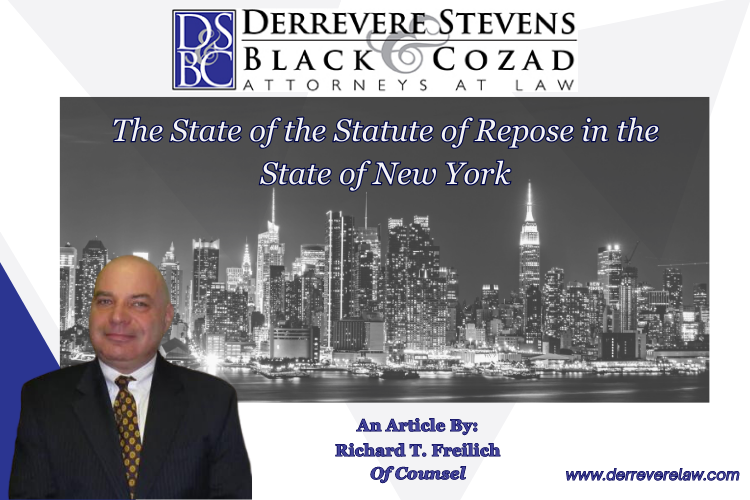The State of the Statute of Repose in the State of New York

New York is famous for not having a Statute of Repose of any sort. For the purposes of this discussion, a Statute of Repose bars a claim against design professionals and contractors after passage of a certain amount of time from project completion. This is different than a Statute of Limitations, which sets a deadline to commence a lawsuit measured from the time of the loss or injury. The rationale behind the Statute of Repose is to allow design professionals and contractors to put a project to rest, at some point. For example, if doors are jammed 25 years after construction, the owner should not be able to make a claim against those that did the design and construction of the entire building. New York and Vermont are the only two states remaining with no Statute of Repose.
Under the current law in New York, contractors and design professionals are exposed to claims for personal injury and property damage resulting from construction defects for an unlimited number of years after a project is completed. New York Civil Practice Law and Rules (“CPLR”) Section 214-d is sometimes referred to as the mini-Statute of Repose. Section 214-d requires wrongful death, personal injury, and property damage claimants to serve design professionals with a written notice of claim, at least ninety days prior to commencement of a lawsuit, when the design or construction work was completed more than ten years prior to the date of the claim. Failure to serve the notice sets the stage for a motion to dismiss pursuant to CPLR § 3211(h) or CPLR § 3212(i). If the defendant can show that more than ten years have passed since the project was completed, and no notice was served, the case will be dismissed. See, Dorst v. The Eggers Partnership, 265 A.D.2d 294, 696 N.Y.S.2d 478 (2 Dept. 1999). This mini “Statute of Repose” is something of a joke. Among other things, even if a claim is dismissed for failure to serve the ninety-day notice, all that the claimant needs to do is serve the notice and start a new action.
New York is revered to be the financial capital of the world, as well as a center of art, fashion, music, theater, media, innovation, and progress. As the law is currently written, design professionals and contractors in New York are subject to claims for an indefinite period of time. After 10 years a claimant must serve a notice, but this could be 20, 30, 50, or more years after the project is completed. This creates a lot of uncertainty for design professionals and contractors and their liability insurers. This must be balanced against the need and expectation by building owners and the public that buildings remain safe and usable structures beyond the 10 years or less that most other states have adopted for their statute of repose.1
The design and construction communities in New York have been lobbying for a Statute of Repose for many years, and now there are bills pending in the New York State Assembly and Senate to repeal CPLR § 214-d in its current form and replace it with a 10-year Statute of Repose for personal injury, wrongful death, and property damage claims asserted against design and construction professionals. In this regard, the Assembly’s Standing Committee on Higher Education and the Senate’s Judiciary Committee, each have been considering a bill (Assembly Bill A35952 and Senate Bill S412723) to impose a limitations period of ten years after the completion of improvements to real property. The bill has had no action for more than a year. A primary motivating factor for the bill, cited by the New York Legislature, is that the purpose of the bill is to curb the continuing rise in insurance premiums by bringing certainty to the scope of post-operational risk to which design professionals and contractors are exposed. In an effort to be fair, each bill provides for a one-year extension to serve a notice of claim, which accrues during the tenth year after the completion of the improvements.
In New York, and even more so in New York City, buildings are expected to last 50 or more years. We do not want the facades of 20-year-old buildings falling to the sidewalk with no recourse to the designers and builders responsible for the failure. We do not want a fire sprinkler main line to fail causing millions of dollars in property damage and endangering the lives of thousands of people.
1A table of the various statutes of repose in the 50 United States can be found here
2The text of the proposed Assembly Bill can be found here
3The text of the proposed Senate Bill can be found here




